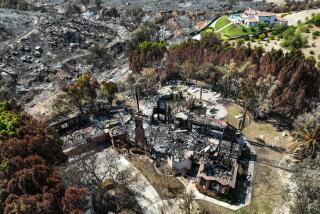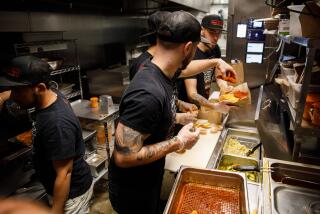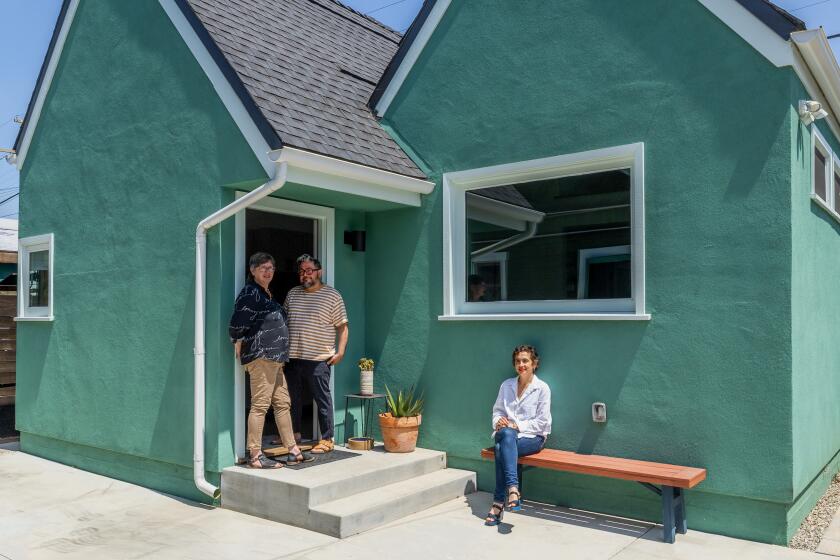Palladium keeps in swing of things
During the most glamorous of Hollywood’s several “Golden Ages,” the Hollywood Palladium on Sunset Boulevard more than held its own against flashier and more expensive nightclubs.
In the 1940s, the Palladium’s dance floor drew stars such as Rita Hayworth and Tyrone Power, and the stars drew tourists as well as working folks, who saved up for the $1 cover charge and a $3 dinner.
During nearly seven decades, the Palladium also attracted powerhouse performers whose musical styles reflected changing tastes, from Frank Sinatra to the Rolling Stones.
And it outlasted most of the other vast ballrooms, including Aragon at Ocean Park and La Monica on the Santa Monica Pier.
Now, as the long-closed Cocoanut Grove at the former Ambassador Hotel gives way to a school and the Earl Carroll Theatre serves as a filming site for children’s television shows, the 67-year-old Streamline Moderne-style Palladium is poised to undergo a massive, yearlong renovation.
Plans are to reopen it under the same name and with the same mission -- a storied venue for music and dancing.
“It remains the oldest and biggest dance venue in the city,” said preservationist Marc Wanamaker, president of Hollywood Heritage Inc.
The Palladium was the project of former film producer Maurice M. Cohen, who built it on the site of the original Paramount Pictures, between Argyle and El Centro avenues. It was designed by architect Gordon B. Kaufman, who also created Greystone Mansion in Beverly Hills, the Santa Anita racetrack in Arcadia and the Los Angeles Times building.
Cohen’s ambition was to create a music mecca where ordinary Angelenos could see top celebrities and dance to big bands. Among his investors was then-Times Publisher Norman Chandler, who owned property on Sunset Boulevard.
The June 10, 1940, groundbreaking ceremony featured comic Ken Murray working a steam shovel with an assist from “Miss Hollywood,” Beverly Bush. Actress Lana Turner and her then-husband, bandleader Artie Shaw, showed up for the event.
For its Halloween 1940 opening, the Palladium was billed as the “million-dollar ballroom-café,” a 40,000-square-foot edifice that soon helped Hollywood cement its reputation as the world’s entertainment capital.
Bandleader Tommy Dorsey began sliding his trombone effortlessly through the opening number, “I’m Getting Sentimental Over You,” with arrangements written by saxophonist and future Los Angeles City Councilman Ernani Bernardi. Singers Jo Stafford, Connie Haines and a skinny young New Jersey crooner named Sinatra wowed the audience with songs backed by the Pied Pipers.
Crowds jammed the dance floor as actress Dorothy Lamour walked onstage to greet Dorsey and cut the ribbon draped with orchids, officially opening the ballroom.
“It’s where the whole city mixed together with the stars,” said Hollywood’s honorary mayor, Johnny Grant, who emceed national broadcasts there and worked as a radio disc jockey for KMPC.
The Palladium’s dance floor could accommodate 7,500.
Throughout the 1940s and beyond, movie stars and fashionable couples, dressed for a night on the town, hit the dance floor, jitterbugging under a sky-blue ceiling with tiny stars to the music of Shaw, Dorsey, Glenn Miller and Benny Goodman.
A few celebrities, including Betty Grable, wound up marrying some of the boys in the band -- in her case, bandleader and trumpeter Harry James.
In radio broadcasts from the ballroom during World War II, Grable, in a soft, sweet, sexy voice, greeted the servicemen’s song requests with a friendly “Hi, fellas.”
But by the 1950s, big bands were fading, and the stars and glitzy couples were staying home to watch television.
The Palladium shifted gears, welcoming charity balls, political events, auto and fashion shows, proms and rock concerts.
In the 1960s, it got a boost from popular bandleader Lawrence Welk, who broadcast his long-running weekly TV program from there.
In November 1961, after President Kennedy spoke at a political luncheon there, souvenir hunters cleaned out the place; one man even walked out with the red plush chair the president had sat in, according to Times stories.
But it wasn’t all glitz and glamour. In 1964, fighting broke out at the Palladium during a jazz festival.
Musicians and singers had walked off the stage, claiming they weren’t being paid, and angry fans started throwing punches -- and bottles.
A bartender chased down a man who tried to make off with four bottles of vodka in the hubbub. Police caught the man.
One person was hospitalized with injuries, according to accounts of the incident in The Times.
In February 1965, the Rev. Martin Luther King Jr. arrived at the Palladium to be honored by city officials and the World Affairs Council for his Nobel Peace Prize. But someone called in a bomb threat, frightening the 1,800 guests. Just hours earlier, police had found 1,400 pounds of dynamite and other stolen explosives in a Los Angeles apartment house.
King made no reference to the bomb threat, but said: “Before the victory is won, some of us will have to get scared up a little bit.”
Over the years, the Palladium’s operators demonstrated their willingness to change with the times, a quality many believe accounts in large part for the venue’s longevity.
Through the 1970s and ‘80s, operators brought diverse icons of rock ‘n’ roll, including Chuck Berry and Led Zeppelin.
Fred Otash, a former Hollywood vice cop and private eye, took the management reins of the club in the late 1970s. His former clients included Sinatra, Turner, Errol Flynn, Howard Hughes and Judy Garland.
The tough-talking Otash, known affectionately as “Mr. O,” tried to get boxing into the Palladium in 1978, but the city denied permission.
The late 1980s and early 1990s brought more turbulence to the Palladium as it booked rap and heavy metal bands. Some nights, police in riot gear arrived to quell disturbances.
After five years of violent incidents, including some shootings and stabbings, the Palladium closed in February 1993. Eight weeks later, it reopened under new management and stricter booking guidelines, resilient once again.
More recently it was transformed into a venue for Hollywood bashes for celebrities such as Lindsay Lohan and Paris Hilton, and a series of concerts by “mope-rock” English singer Morrissey.
Concert promotion giant Live Nation agreed to renovate the privately owned building and to reopen it late next year.
Despite its colorful history, the Palladium has not been designated a historic landmark. But that doesn’t mean it isn’t treasured.
As the building closes for renovations, documentarian Esther Rydell, in a tribute to the venue that played host to five presidents and countless entertainers, is piecing together decades of film footage, photographs, documentation and interviews with celebrities who played and danced there.
“It’s like looking at society through the eye of the Palladium,” Rydell said.
--
More to Read
Inside the business of entertainment
The Wide Shot brings you news, analysis and insights on everything from streaming wars to production — and what it all means for the future.
You may occasionally receive promotional content from the Los Angeles Times.






